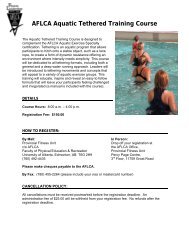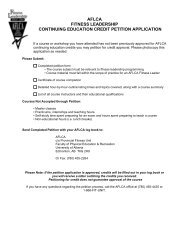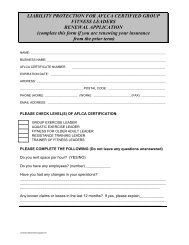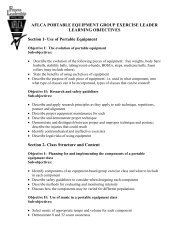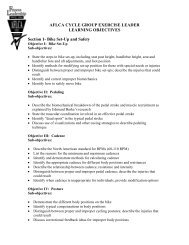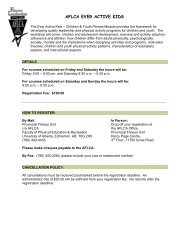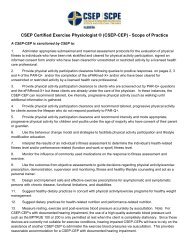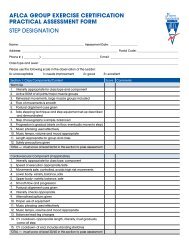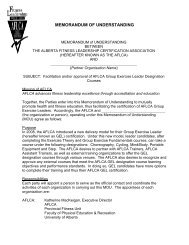Alberta CSEP HFP - Provincial Fitness Unit
Alberta CSEP HFP - Provincial Fitness Unit
Alberta CSEP HFP - Provincial Fitness Unit
You also want an ePaper? Increase the reach of your titles
YUMPU automatically turns print PDFs into web optimized ePapers that Google loves.
<strong>Alberta</strong> <strong>CSEP</strong> <strong>HFP</strong><br />
Motivating People to Move:<br />
A Look at Motivational Interviewing<br />
by Marni Armstrong, PhD Candidate<br />
<strong>Alberta</strong> <strong>CSEP</strong> has developed an additional way for you to<br />
obtain Professional Development Credits. Read the following<br />
researched article and complete the corresponding<br />
exam. This exam is worth 1.0 <strong>CSEP</strong> PDC credit and<br />
can be accessed online at:<br />
www.provincialfitnessunit.ca/fitness-informer-quizzes/<br />
Despite the strong evidence demonstrating the benefits<br />
and protective effects of exercise, much of the<br />
population remains inactive. Recent data suggest<br />
that 52 per cent of Canadians are sedentary and not<br />
active enough to gain health benefits. Additionally,<br />
many of those who begin a regular exercise program<br />
do not continue long-term: 50 per cent of individuals<br />
who start an exercise program will drop out in<br />
the first three to six months. In order to achieve the<br />
long-term health benefits of exercise, maintenance<br />
of the behaviour is essential.<br />
Finding ways to help people change their behaviour<br />
and maintain change is an important role for<br />
the fitness professional. Traditional approaches to<br />
promoting behaviour change involve the giving of<br />
“expert advice,” with the assumption that people<br />
will “follow it”. Advice-giving alone works for some<br />
time, but anyone who has tried it to encourage clients<br />
to change will be familiar with its limitations.<br />
Changing behaviour is hard; being hesitant about<br />
change is normal and a part of human nature.<br />
Many people looking to make a behaviour change<br />
can be ambivalent about it: they want it, and they<br />
don’t. Motivational interviewing was developed<br />
as a way to help people work through ambivalence<br />
and commit to healthy change. William Miller and<br />
Stephen Rollnick (2002), who pioneered motivational<br />
interviewing, define it as “a person-centred<br />
approach designed to help people initiate and<br />
maintain health behaviour change. It is a technique<br />
designed to activate patients’ own intrinsic<br />
motivation for change by exploring and resolving<br />
ambivalence.”<br />
Originally developed in the substance abuse<br />
field, motivational interviewing has been gaining<br />
popularity in the health-care setting, as issues of<br />
motivation and adherence are not unique to the<br />
addictions field. In recent years, increasing evidence<br />
recommends its use in lifestyle counselling, including<br />
physical activity counselling.<br />
Ambivalence: “I Want to Exercise<br />
More, But…”<br />
Resolving ambivalence is a key to developing commitment<br />
and sustained behaviour change in motivational<br />
interviewing. The communication pattern<br />
between the health-care professional and client will<br />
greatly influence this. For example, a client who has<br />
been recently diagnosed with diabetes may perceive<br />
advantages and disadvantages to change. Clients<br />
may be motivated to exercise in order to control<br />
their blood sugar, improve their cardiovascular<br />
fitness, and to live the life they want. On the other<br />
hand, they may perceive exercise as too uncomfortable,<br />
lack the energy, and be anxious about starting.<br />
Clients may also worry about the sacrifices required<br />
in other aspects of life to find the time to exercise.<br />
Faced with clients who are ambivalent about<br />
change, professionals commonly argue for the<br />
<strong>CSEP</strong> PDC article<br />
change side, explaining the benefits and importance<br />
of change, using scare tactics about the consequences<br />
of no change and how to go about it. This “righting<br />
reflex” stems from a genuine desire to help the<br />
client. Giving unsolicited advice can be detrimental,<br />
however. It can leave the client having to defend<br />
why exercise might be difficult or unpleasant and<br />
may generate the response, “Yes, I know exercise is<br />
important, but…”.<br />
Attitudes and beliefs are shaped by what we say and<br />
clients tend to believe what they hear themselves<br />
say. Therefore clients will be more likely to act on<br />
their own arguments rather than those of another<br />
person. The goal of motivational interviewing is<br />
to elicit and evoke from clients their reasons for<br />
change and pull out their “change talk” and have<br />
them argue for change. You want to focus on<br />
understanding the client’s dilemma and encourage<br />
the belief that change is possible.<br />
The “Spirit” of Motivational Interviewing<br />
Motivational interviewing is not a technique that<br />
involves tricking people into doing what they do<br />
not want to do. Rather, it is a way of interacting<br />
that draws on the client’s own motivations and values.<br />
The spirit has three elements: it is collaborative,<br />
evocative, and honours client autonomy.<br />
• It is collaborative in the sense that the professional<br />
and client are working together in an<br />
equal partnership, instead of an unequal relationship<br />
where the expert directs the passive<br />
client. This is vital in health behaviour change,<br />
because ultimately it is only the client who can<br />
make the change happen.<br />
• Evocation refers to eliciting the client’s own<br />
concerns and motivation.<br />
• Honouring autonomy is shown by respecting<br />
and accepting the client’s right and ability to<br />
choose.<br />
These characteristics describe the underlying spirit<br />
of motivational interviewing and the mindset<br />
with which one approaches conversations about<br />
behaviour change.<br />
Guiding Principles<br />
In talking with people about behaviour change, you<br />
want to create an atmosphere that is favourable to<br />
change by following four general principles.<br />
24 www.provincialfitnessunit.ca
motivating PDC article cont’d<br />
Express Empathy<br />
• Demonstrate a non-judgmental understanding<br />
of the person’s perspective; this is done by<br />
reflecting the client’s point of view.<br />
Example:<br />
• “It is hard to fit exercise into your busy<br />
schedule.”<br />
Develop Discrepancy<br />
• Help people explore gaps between their<br />
current behaviour and the lives they would<br />
like to lead, by evoking and exploring the<br />
ambivalence.<br />
Examples:<br />
• “How would things be a year from now if you<br />
were able to exercise regularly?”<br />
• “What might happen if you don’t make this<br />
change?”<br />
Support Self-Efficacy<br />
Encourage and strengthen optimism for change as<br />
well as the client’s sense of the possibility of change.<br />
Examples:<br />
• “The fact that you are taking the time to<br />
discuss this issue with me now is a big step<br />
towards making positive change.”<br />
• “Once you make up your mind, you really<br />
stick with it.”<br />
Roll with Resistance<br />
Avoid arguing for change; do not oppose resistance.<br />
Invite the person to enter the process of problem<br />
solving.<br />
Examples:<br />
• “You don’t see yourself as unfit.” (said with no<br />
sarcasm)<br />
• “What makes it hard to exercise regularly?”<br />
Following these principles, you can focus on<br />
understanding the person’s dilemma. Rather than it<br />
being the practitioner arguing for change, the goal<br />
is to work with the client to evoke the person’s own<br />
reasons for change.<br />
Using client-centred counselling strategies such as<br />
open-ended questions, reflective listening, and summarizing,<br />
you can help build the person’s motivation<br />
for change. The following gives some examples<br />
of how to begin a motivational interview.<br />
Begin with an open-ended question, such as:<br />
their lives. How would you describe your program<br />
right now?”<br />
“On a scale of zero to 10 (where zero is not at all<br />
important and 10 is extremely important), how<br />
important is it to you to exercise on a regular basis?”<br />
Instead of importance (need), you could also ask:<br />
• how much they want (desire)…<br />
• how confident they are that they could (ability)…<br />
• how committed (commitment) they are…<br />
Some more examples of open-ended questions:<br />
• Where would you like to be?<br />
• What’s at stake if you don’t get there?<br />
• What might you do to get there?<br />
• In what ways do you think you would feel<br />
better?<br />
• Why would you want to make a change in this<br />
part of your life?<br />
• If you were to…, how would life be different?<br />
• What have you already done?<br />
• What might need to be different for you to<br />
think about changing?<br />
Follow up to zero to 10 positioning:<br />
And why are you at a ___and not zero? What<br />
might happen that could move you from ___to a<br />
[higher score]?<br />
Motivational interviewing is an evidence-based<br />
method designed to increase client motivation,<br />
which makes it ideal for fitness professionals working<br />
to help people make changes in their physical<br />
activity. Empathetic listening and non-judgmental<br />
reflections that characterize this communication<br />
style encourage clients to resolve ambivalence by<br />
carefully drawing out and reinforcing the client’s<br />
own reasons for change.<br />
Read on…<br />
Rollnick, Stephen, William R. Miller, and Christopher<br />
C. Butler. 2008. Motivational Interviewing<br />
in Health Care: Helping Patients Change Behavior.<br />
Guilford Press: New York.<br />
Rosengren, David B. 2009. Building Motivational<br />
Interviewing Skills: A Practitioner Workbook. Guilford<br />
Press: New York.<br />
<strong>Alberta</strong> <strong>CSEP</strong> <strong>HFP</strong><br />
References available upon request.<br />
Congratulations New<br />
<strong>Alberta</strong> <strong>CSEP</strong> Members!<br />
September 1 - December 15, 2010<br />
—CEPs—<br />
Christine Arnot<br />
Gillianne Bechard<br />
Rianne Coppus<br />
Jasmine Gaulin<br />
Miyoshi Kinoshita<br />
Katarzyna Nastalska<br />
Jeffery William Osadec<br />
Kelsey Peressini<br />
Paul Vrskovy<br />
Patrick Welsh<br />
—CPTs—<br />
Alicia N. Bell<br />
Stephen Breitkreuz<br />
Josh Calderon<br />
Andrea Cihal<br />
Jesse Couture<br />
Paul DeCock<br />
Hali Duncan<br />
Chantelle Elson<br />
Steve Gasper<br />
Erin Gillespie<br />
Mia Gower<br />
Merissa Haika<br />
Shannon Hein<br />
Kimmy Hillier<br />
Elizabeth Hitt<br />
Dustin Johnson<br />
Travis Jones<br />
Holly Kornelson<br />
Jeff Litwin<br />
Fernando Lopez<br />
Paula McDonald<br />
Cullen McIver<br />
Shantelle Murphy<br />
Wynand Nel<br />
Douglas Owoo<br />
John Pennefather<br />
Carly Presakarchuk<br />
Michael Strocel<br />
Jordan Swanson<br />
Julianne Symons<br />
Megan Triska<br />
Donald Tse<br />
Kaitlin Villeneuve<br />
Amy van der Lee<br />
Sara Vogel<br />
Lindsay Walker<br />
Matthew Wong<br />
MelissaWong<br />
Adam John Yeske<br />
“A lot of people have trouble fitting exercise into<br />
www.provincialfitnessunit.ca 25



